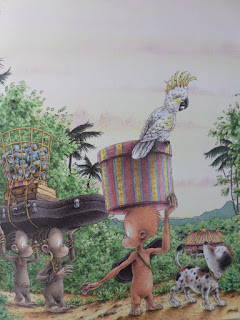Very often, white people wanting to engage in anti-racism (including myself)
unawarely end up perpetuating and reinforcing racism. White supremacist
assumptions are so engrained in our world view that we are sometimes completely
blind to a Black Consciousness perspective. However, we must recognise that, no
matter how good our intentions, exercising anti-racism will necessarily bring
to counterproductive results as long as we do not make the effort to actively engage
in Critical Whiteness. We cannot possibly be allies in the anti-racist struggle
without trying to see things from the perspective of People of Colour.
Once again, I draw my evidence from the very racist world of children’s
literature. Don’t take it as a provocation. As a matter of fact, the world of
children’s literature is VERY racist.
Pili Mandelbaum’s “Noire comme le café, blanc comme la lune” (published
in English with the title “You be me, I’ll be you”) is a highly praised book
which is widely recommended to address the topic of difference with young
children. Of course, the fact that the book was published by the prestigious École
des Loisirs and that it continues to receive enormous praise is very telling of
the supremacist whiteness of the book market at all levels.
Let us start from the title: Black like coffee, white like the moon. One
should not even need to look further than that to know this book goes in the
wrong direction. The book cover, portraying a white man and a little Black girl
makes clear who is what. Without wanting to go deep into the implicit hierarchy
juxtaposing the ground versus the sky and the physical versus the metaphysical,
the association of dark skin with coffee is alarming enough. Along the history
of racism, Black skin has been associated with items of consumption and, by
extension, Black people themselves and Black women and children in particular.
Therefore, no, it is no longer acceptable from white people to refer to
chocolate, coffee, cappuccino or alike denominations when describing different shades
of Black. Black bodies deserve better than that. Adding to the injury, there is
no parallel consumptive comparison for the white man, who is associated with
the moon, with all its poetical and metaphysical meanings. Something of the
kind “Black like coffee, white like mozzarella cheese” might be more acceptable,
as irony would highlight the denigrating character of such comparisons.
Nevertheless, such alternative title would not be palatable for a white
readership.
While the book is most probably cherished by many progressive whites for
its focus on acceptance and self-esteem, its approach cannot genuinely bring
forward a notion of racial equity. The main obstacle to equity in this story is
that racism is presented as a subjective issue rather than a structural system
of oppression. In fact, racism itself is not presented at all. On the contrary,
it is completely neglected and obliterated in the name of a most vexingly naive
colour-blindness.
This is the story of a little girl who does not find herself pretty. She
does not find herself pretty because of the colour of her skin. There is
nothing in the story to suggest that the problem comes from outside rather than
from herself, that her lack of self-appreciation is a result of structural
racism. On the contrary, the issue is trivialised and reduced to skin shade and
personal taste rather than racism. Foregrounding the idea that everybody wishes
to be different at some point, the comparison with the white woman getting a
good tan in the sun is stupid and denigrating. In the assumption of a white
reader, the little girl has a race, not her father. Her skin is the problem, rather
than the meanings society charges it with. In such a way, the real issue of
racism disappears from the picture. However, not addressing racism when it is
actually the central issue is a huge hypocrisy that cannot be excused.
Most problematic of all is the strategy the father comes up with in
order to convince the little girl that she is indeed pretty. He covers her face
with white flour, paints his own in brown, arranges his hair in a parody of locks and has the two of them go out in
public to finally meet the Black mother (not surprisingly, she, who is the Black
character who should have a say on the matter, is not offered an active voice).
Grotesque and frankly offensive pictures accompany this pathetic masquerade which
evokes the racist practice of Blackface (if you do not know it, get informed or
else drop your anti-racist endeavour). The English title (You be me, I’ll be
you), only apparently softer than the original in French, actually focuses on
the worst aspect of this book and brings forward the deceptive idea that Black
and white identities can be interchangeable and on the same level. Now, this is
a no-go.
Dear white people, this is a racist book. If you still don’t see it,
please consider interrogating your white fragile self. (Check out Robin
DiAngelo’s “white fragility”concept).

















